Monroe County like rest of state: Bump in COVID-19 numbers somewhat outpaces testing; deaths, hospitalizations declining
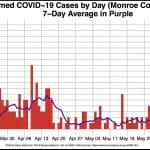
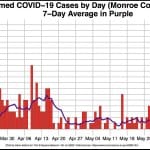
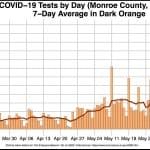
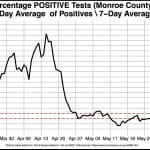
Yesterday’s 18 new confirmed positive COVID-19 cases for Monroe County put the 7-day rolling average at 8.7 confirmed cases per day.
That’s about 2.5 more cases per day than the highest 7-day rolling average back in April.
The total number of confirmed COVID-19 cases in Monroe County now stands at 294.
The increased raw number of confirmed cases comes in the context of increased numbers of tests in the county. Hospitalizations and deaths in the county are not showing an increase similar to the higher number of confirmed cases.
That’s similar to the statewide picture: Confirmed positive cases are showing increased numbers, along with higher testing numbers, while death numbers and hospitalizations continue to decline.
But a key stat shows that not all of the increased confirmed positive cases can be chalked up to increased testing numbers.
The rolling 7-day rolling average rate of positive tests—the percentage of tests that come back positive for COVID-19—has increased in Monroe County from under 2 percent on June 26 to around 3.5 percent through July 1.
For the same period, the 7-day rolling rate of positive tests statewide has increased from around 5 percent to about 6 percent.
The number of tests reported for each date on the state’s COVID-19 dashboard comes with a caveat about the “preliminary” nature of the positive rate calculations. The caveat appears to be well-grounded. The number of tests performed in Monroe County on July 3 is reported on the dashboard as 2, even while 10 confirmed cases were reported for that date.
The state takes information that it receives on a given day and assigns it retroactively to the appropriate calendar date for the activity. If a test was done on July 3, it will eventually be assigned to July 3 on the dashboard, even if it’s reported to the state on, say, July 8. So the July 3 testing numbers are likely to increase on future dashboard reports. Because of the preliminary nature of the testing data, the last three dates are elided in calculations by The Square Beacon for testing graphs.
The number of COVID-19 tests that have been done in Monroe County has roughly doubled for each of the last three months, rising from 1,014 in April, to 2,365 in May, to 4,528 in June.
The number of positive tests shows a different pattern over those three months.
In April, Monroe County logged 92 confirmed COVID-19 positive cases. In May, that number dropped to 41, which is less than half of April’s total, despite twice the number of tests. In June, 90 confirmed cases were recorded for Monroe County—more than double the number of cases in May, but with less than double the number of tests.
A more precise approach, which also brings the calculations up to the latest non-preliminary testing numbers, relies on 30-day intervals instead of months. For the 30-day period ending July 1, 96 positives were logged out of 4,517 tests—a positive rate of 2.13 percent. For the previous 30-day period, 40 positive tests were logged, out of 2,485 total tests, for a rate of 1.61 percent.
If the number of positive tests had maintained their same rate from the first 30-day period to the next, then just 72 positive cases, instead of 96, would have been seen in the second 30-day period.
The rolling 7-day average rate of positive cases has increased in Monroe County from under 2 percent on June 26 to around 3.5 percent through July 1.
The general picture across the state is similar to Monroe County’s. Indiana’s 7-day average for new confirmed COVID-19 cases is now around 443 cases a day. It hasn’t been above 400 since June 8. Increased test numbers account for some but not all of that increase. Percent positives has been increasing since mid-June from about 4.5 percent to 6 percent.
Even if the number of confirmed cases is higher, the severity of Monroe County cases, as well as cases across the state, seem to be less than a few months ago.
The most recent ICU admission in Monroe County was on May 27.
Overall hospital admissions in Monroe County in June numbered 8, compared to 23 in April, despite similar positive test numbers. Those numbers: In April there were 92 confirmed cases; in June, there were 90 confirmed cases.
Statewide, the number of hospitalizations each day has been under 100 a day since the beginning of June. Before that, hospitalizations were routinely over 100 a day, on several occasions going over 150 a day.
The most recent of Monroe County’s 28 deaths was recorded for June 21.
After peaking at the end of April at 41.5 deaths a day, since May 27, the 7-day average number of deaths per day in Indiana has been under 20. Since June 25 the 7-day average number of death per day has been under 10.
On Thursday, Monroe County’s health officer issued a separate COVID-19 order that is slightly more restrictive than the statewide directive.
The local order started July 4.
The local health order includes a requirement that businesses post signs encouraging their patrons to wear masks, but does not mandate the wearing of masks.
If confirmed COVID-19 numbers continue to rise, even before Indiana University students return to town for fall classes and before K-12 classes start, the calls for a legal mandate for mask wearing could get louder.
During last week’s Thursday’s press conference, Monroe County’s health administrator, Penny Caudill said the health officer has the authority to impose a mandate for residents to wear facial coverings when in public. The possibility of issuing a local mandate “has always been on the table,” she said.
Bloomington’s mayor, John Hamilton, added to the point about jurisdictional authority by saying that Bloomington’s city council could enact an ordinance for Bloomington. But the mayor indicated a preference for working on a unified approach with the county government. Hamilton said that it would be preferable to have a national order, given that COVID-19 is a national pandemic.
Caudill said the preference in Monroe County has been to “use the approach of everybody owning their own responsibility.” She would rather get voluntary compliance, instead of mandating it, adding that some people will not wear a mask, no matter what.
Statewide charts
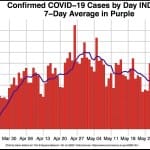
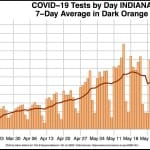
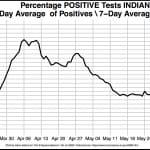




Comments ()